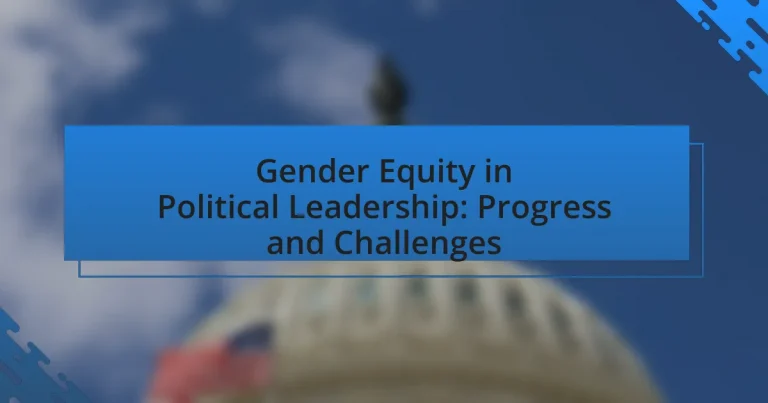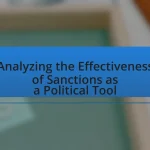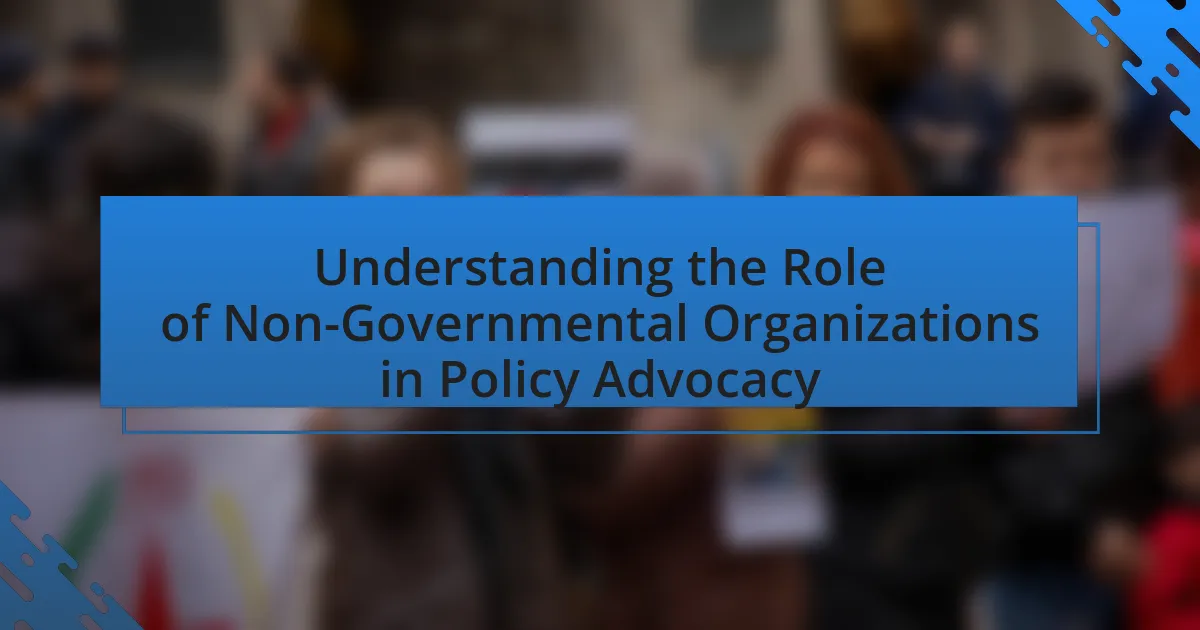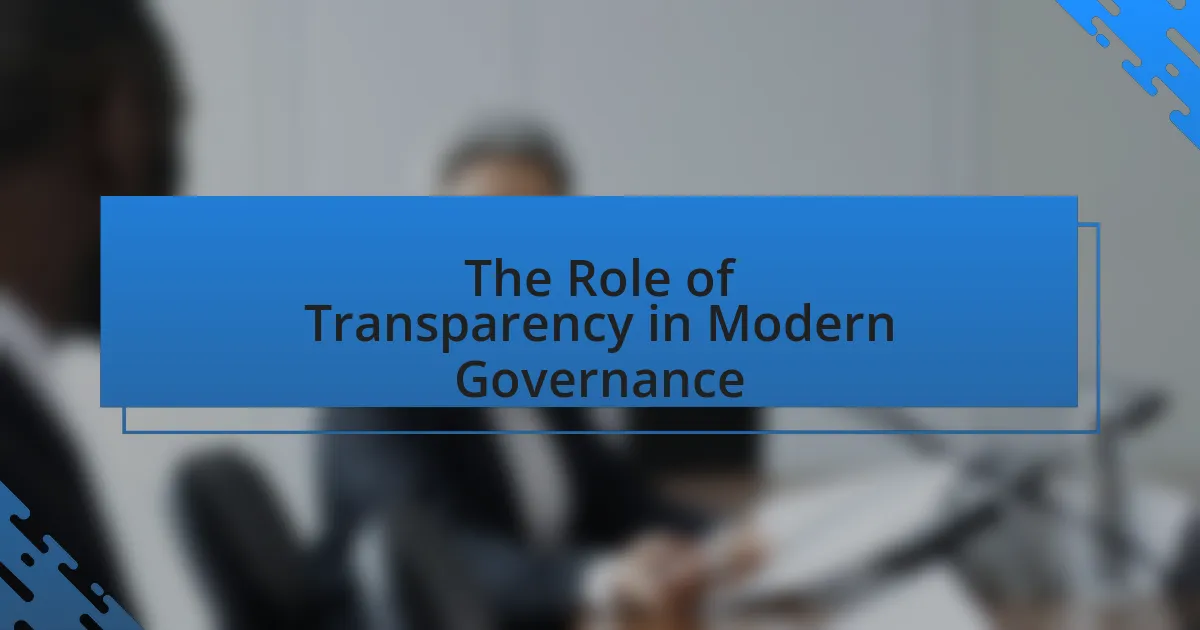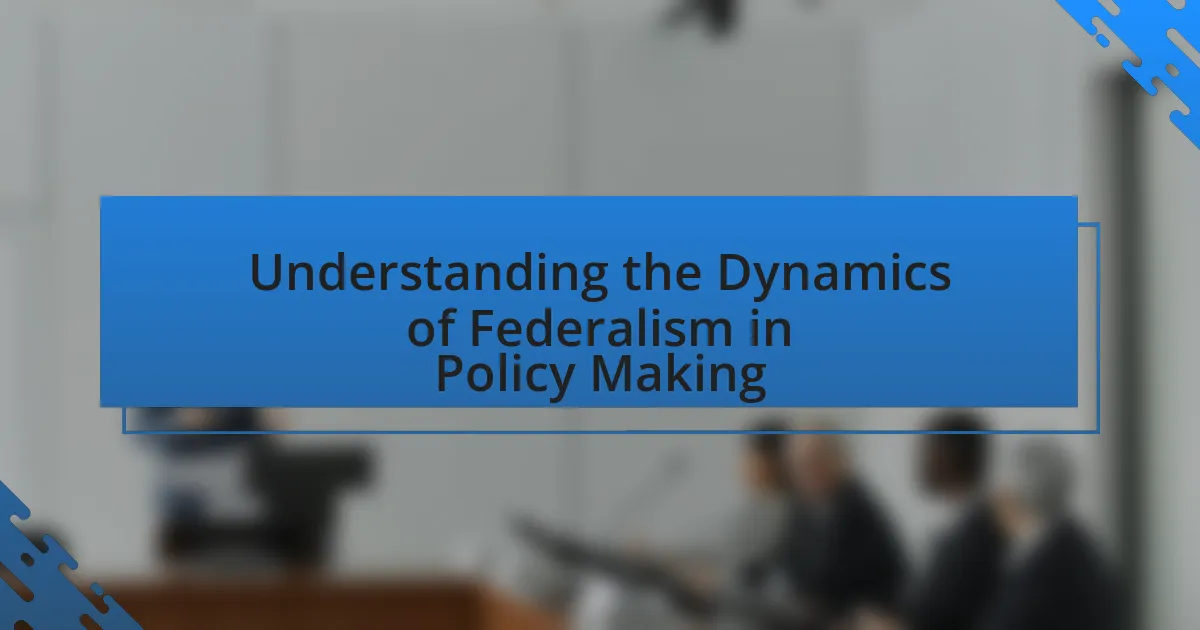Gender equity in political leadership is defined as the fair representation and participation of individuals of all genders in political decision-making processes. This article examines the importance of gender equity in governance, highlighting its impact on policy-making and social outcomes. It explores historical contexts, current statistics, and the effectiveness of initiatives aimed at increasing female representation in political roles. Additionally, the article addresses the challenges and societal attitudes that hinder progress, while outlining strategies for promoting gender equity, including mentorship programs and gender quotas. The future prospects for gender equity in political leadership are also discussed, emphasizing the role of global movements and emerging technologies in advancing this critical issue.
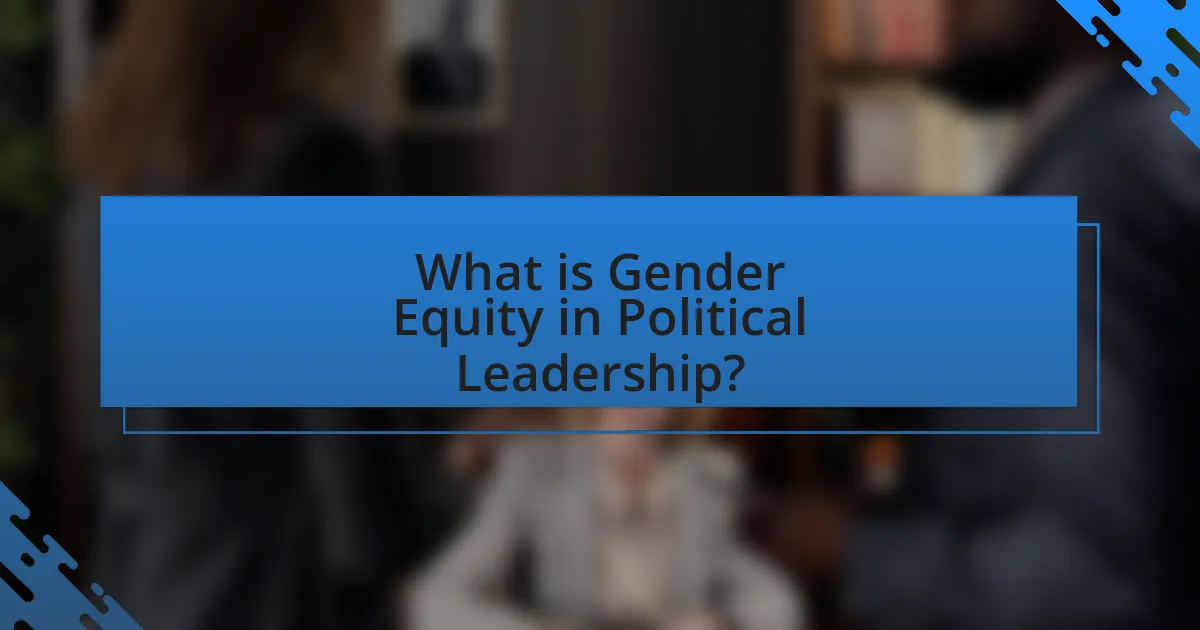
What is Gender Equity in Political Leadership?
Gender equity in political leadership refers to the fair representation and participation of individuals of all genders in political decision-making processes. This concept emphasizes the need for equal opportunities for women and men to engage in leadership roles, ensuring that diverse perspectives are included in governance. Evidence shows that countries with higher levels of gender equity in political leadership, such as Rwanda, which has the highest percentage of women in parliament globally at over 60%, tend to have more comprehensive policies addressing social issues and improved governance outcomes.
Why is Gender Equity important in Political Leadership?
Gender equity is important in political leadership because it ensures diverse perspectives and experiences are represented in decision-making processes. Research indicates that when women participate in political leadership, policies are more likely to address issues such as healthcare, education, and social welfare, which disproportionately affect women and marginalized communities. For instance, a study by the Inter-Parliamentary Union found that countries with higher percentages of women in parliament tend to have more progressive legislation on gender equality and family policies. This demonstrates that gender equity not only promotes fairness but also enhances the effectiveness and responsiveness of governance.
What are the historical contexts of Gender Equity in Political Leadership?
The historical contexts of gender equity in political leadership reveal a gradual evolution influenced by social movements, legal reforms, and cultural shifts. In the early 20th century, women’s suffrage movements in countries like the United States and the United Kingdom marked significant milestones, culminating in the 19th Amendment in 1920 and the Representation of the People Act in 1918, respectively, which granted women the right to vote and participate in political processes.
Subsequent decades saw the rise of feminist movements, particularly in the 1960s and 1970s, advocating for equal representation and challenging systemic barriers in political institutions. The United Nations’ adoption of the Convention on the Elimination of All Forms of Discrimination Against Women (CEDAW) in 1979 further solidified international commitments to gender equity in political leadership.
By the late 20th and early 21st centuries, many countries implemented quotas and affirmative action policies to increase women’s representation in political offices, leading to notable examples such as Rwanda, which achieved over 60% female representation in its parliament by 2021. These historical contexts illustrate the ongoing struggle and progress toward achieving gender equity in political leadership across various global landscapes.
How does Gender Equity impact governance and policy-making?
Gender equity significantly enhances governance and policy-making by ensuring diverse perspectives are included in decision-making processes. When women and marginalized genders participate equally in leadership roles, policies are more likely to address the needs of the entire population, leading to more comprehensive and effective governance. Research indicates that countries with higher gender equity in political representation tend to have better social outcomes, such as improved health and education metrics. For instance, a study by the Inter-Parliamentary Union found that nations with at least 30% women in parliament are more likely to pass legislation that benefits women and children, demonstrating a direct correlation between gender equity and positive policy outcomes.
What are the current statistics on Gender Equity in Political Leadership?
As of 2023, women hold approximately 26% of parliamentary seats globally, reflecting a slow but steady increase in gender equity in political leadership. This statistic indicates that while progress has been made, significant disparities remain, with only 12 countries achieving gender parity in their national legislatures. Furthermore, women occupy around 22% of ministerial positions worldwide, highlighting ongoing challenges in achieving equal representation in political decision-making roles. These figures are sourced from the Inter-Parliamentary Union and UN Women, which regularly track and report on gender representation in political leadership.
How do different countries compare in terms of Gender Equity in Political Leadership?
Countries vary significantly in gender equity in political leadership, with Nordic countries like Iceland, Finland, and Norway leading in representation, often exceeding 40% female participation in their parliaments. In contrast, countries such as Japan and the United States have lower female representation, with Japan’s national legislature comprising only about 10% women and the U.S. Congress around 27% as of 2023. The Global Gender Gap Report 2021 by the World Economic Forum highlights these disparities, indicating that while some nations have made substantial progress, others lag behind due to cultural, social, and institutional barriers that hinder women’s political participation.
What trends have emerged in recent years regarding Gender Equity in Political Leadership?
Recent years have seen a significant increase in the representation of women in political leadership roles globally. For instance, as of 2023, women hold approximately 26% of parliamentary seats worldwide, a notable rise from 11% in 1995, according to the Inter-Parliamentary Union. Additionally, more countries are implementing gender quotas to ensure women’s participation in politics, with over 130 countries adopting such measures. Furthermore, the emergence of grassroots movements advocating for gender equity has led to heightened awareness and support for female candidates, contributing to their electoral success. These trends indicate a growing recognition of the importance of gender equity in political leadership and its impact on governance and policy-making.
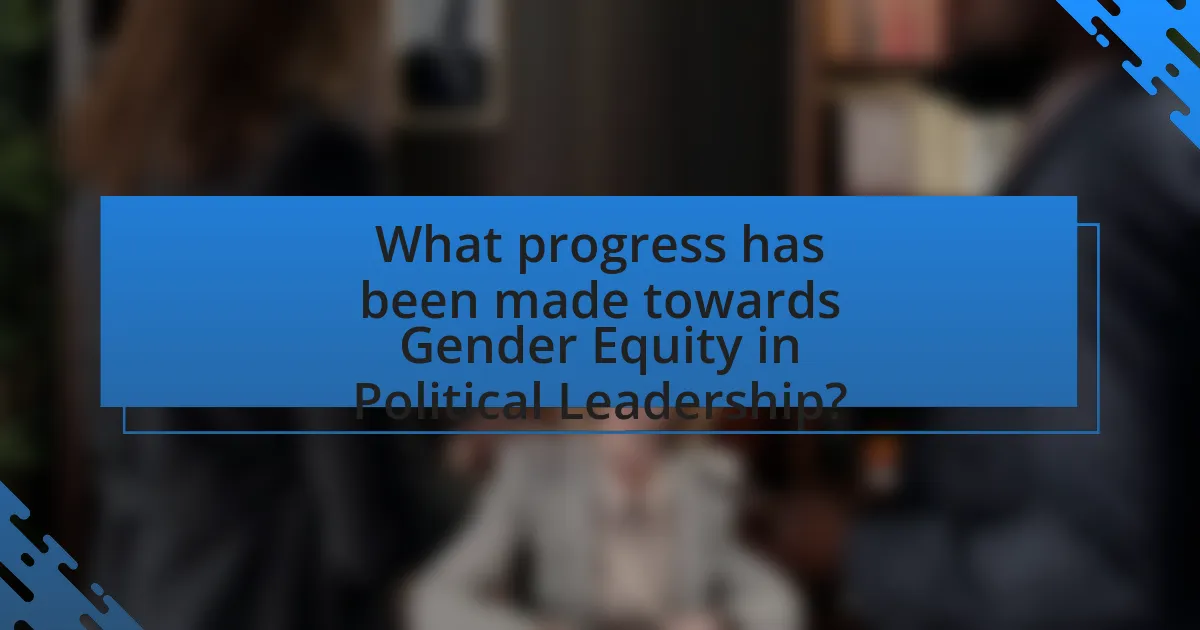
What progress has been made towards Gender Equity in Political Leadership?
Significant progress has been made towards gender equity in political leadership, evidenced by an increase in the number of women holding political office globally. As of 2023, women occupy approximately 26% of parliamentary seats worldwide, a notable rise from 11% in 1995, according to the Inter-Parliamentary Union. Additionally, the number of countries with women serving as heads of state or government has increased, with 15 women in such positions as of 2023, compared to just 5 in 2000. These advancements reflect ongoing efforts to promote gender parity through legislative reforms, quotas, and advocacy initiatives aimed at empowering women in political spheres.
What initiatives have been implemented to promote Gender Equity in Political Leadership?
Various initiatives have been implemented globally to promote gender equity in political leadership, including gender quotas, mentorship programs, and training workshops. Gender quotas, such as those established in countries like Rwanda, mandate a certain percentage of women in political positions, resulting in women holding over 60% of parliamentary seats. Mentorship programs, like the Women in Public Service Project, connect aspiring female leaders with experienced mentors to enhance their leadership skills. Additionally, training workshops, such as those conducted by the United Nations Development Programme, focus on empowering women with the necessary skills and knowledge to participate effectively in politics. These initiatives collectively aim to create a more balanced representation of genders in political leadership roles.
How effective have these initiatives been in increasing female representation?
The initiatives aimed at increasing female representation have been effective, resulting in a notable rise in women’s participation in political leadership roles. For instance, as of 2023, the global average of women in national parliaments reached 26.1%, a significant increase from 11.3% in 1995, according to the Inter-Parliamentary Union. This upward trend indicates that targeted policies, such as gender quotas and mentorship programs, have successfully contributed to enhancing female representation in governance.
What role do political parties play in advancing Gender Equity?
Political parties play a crucial role in advancing gender equity by shaping policies, promoting female candidates, and influencing public discourse. They can implement gender quotas, which have been shown to increase women’s representation in legislative bodies; for example, countries like Rwanda have achieved over 60% female representation in parliament through such measures. Additionally, political parties can advocate for laws that address gender-based violence and discrimination, thereby creating a more equitable society. Research indicates that when women hold leadership positions within parties, they are more likely to prioritize gender equity issues, leading to more inclusive governance.
What are the key challenges to achieving Gender Equity in Political Leadership?
The key challenges to achieving gender equity in political leadership include systemic barriers, cultural biases, and lack of support networks. Systemic barriers manifest in the form of discriminatory laws and practices that hinder women’s participation in politics. Cultural biases often perpetuate stereotypes that question women’s leadership capabilities, leading to underrepresentation. Additionally, the lack of support networks, such as mentorship and funding for female candidates, further exacerbates the challenge. According to the Inter-Parliamentary Union, as of 2021, women hold only 25.5% of parliamentary seats globally, highlighting the persistent inequities in political representation.
What societal attitudes hinder Gender Equity in Political Leadership?
Societal attitudes that hinder gender equity in political leadership include pervasive stereotypes about gender roles, the perception that leadership is a masculine trait, and biases that question women’s competence in political positions. These attitudes manifest in various ways, such as the underrepresentation of women in political offices and the prevalence of discriminatory practices during elections. For instance, research by the Inter-Parliamentary Union indicates that women hold only 26.1% of parliamentary seats globally, reflecting systemic barriers rooted in societal beliefs about gender capabilities. Additionally, studies show that women candidates often face harsher scrutiny and criticism compared to their male counterparts, further perpetuating the cycle of inequality in political leadership.
How do institutional barriers affect women’s participation in political leadership?
Institutional barriers significantly hinder women’s participation in political leadership by creating systemic obstacles that limit their access to power and decision-making roles. These barriers include discriminatory laws, lack of support for work-life balance, and insufficient representation in political institutions. For instance, a study by the Inter-Parliamentary Union found that countries with gender quotas in political parties see a higher percentage of women in leadership positions, demonstrating that institutional reforms can effectively increase women’s representation. Additionally, the World Economic Forum’s Global Gender Gap Report highlights that countries with more equitable political structures tend to have better outcomes for women’s political participation, reinforcing the impact of institutional frameworks on gender equity in leadership.
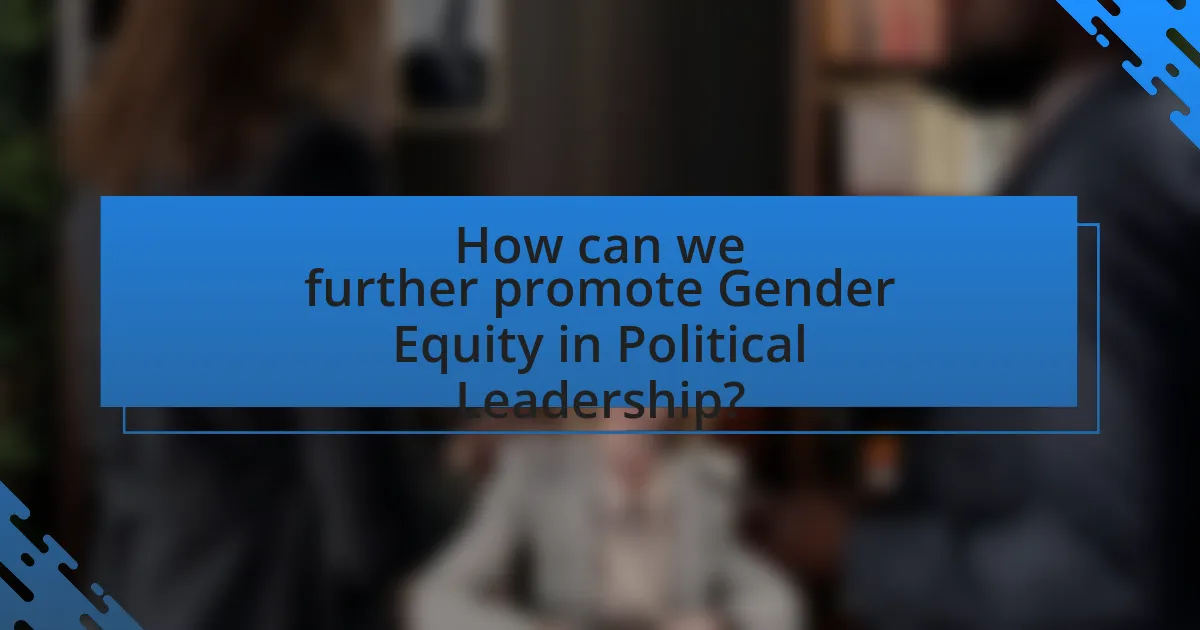
How can we further promote Gender Equity in Political Leadership?
To further promote gender equity in political leadership, implementing quotas for female representation in political offices is essential. Research indicates that countries with gender quotas, such as Rwanda, have achieved over 60% female representation in parliament, significantly enhancing women’s political participation. Additionally, providing mentorship programs for aspiring female leaders can empower women to pursue political careers, as evidenced by initiatives like the Women in Public Service Project, which has successfully trained women leaders globally. These strategies collectively foster an environment conducive to gender equity in political leadership.
What strategies can be employed to enhance Gender Equity in Political Leadership?
To enhance gender equity in political leadership, implementing quotas for female representation in political offices is a highly effective strategy. Research indicates that countries with gender quotas have seen significant increases in women’s political participation; for example, Rwanda achieved over 60% female representation in its parliament after adopting such measures. Additionally, providing mentorship programs for aspiring female leaders can foster their development and increase their chances of success in political roles. Studies show that mentorship positively impacts women’s confidence and skills, leading to higher rates of election and appointment. Furthermore, promoting gender-sensitive policies and practices within political parties can create a more inclusive environment, encouraging women to engage in politics. Evidence from various political contexts demonstrates that parties prioritizing gender equity in their platforms attract more female candidates and voters.
How can education and awareness campaigns contribute to Gender Equity?
Education and awareness campaigns can significantly contribute to gender equity by promoting understanding and challenging stereotypes related to gender roles. These campaigns educate individuals about the importance of equal rights and opportunities for all genders, fostering a culture of inclusivity. For instance, research from the World Economic Forum indicates that countries with comprehensive gender education programs have seen a reduction in gender disparities in various sectors, including political leadership. By raising awareness about the barriers women face and highlighting successful female leaders, these campaigns empower individuals to advocate for change, ultimately leading to increased representation and participation of women in political leadership roles.
What role does mentorship play in supporting women in political leadership?
Mentorship plays a crucial role in supporting women in political leadership by providing guidance, networking opportunities, and skill development. Women often face unique challenges in political environments, and mentorship helps them navigate these obstacles by connecting them with experienced leaders who can share insights and strategies. Research indicates that women with mentors are more likely to pursue leadership roles and achieve higher levels of success in politics. For instance, a study by the Center for American Women and Politics found that women who had mentors were significantly more likely to run for office compared to those without mentorship. This demonstrates that mentorship not only empowers women but also contributes to increasing their representation in political leadership.
What best practices can be adopted to ensure sustained progress in Gender Equity?
To ensure sustained progress in Gender Equity, organizations should implement comprehensive policies that promote equal opportunities and representation for all genders. These policies should include targeted recruitment strategies that aim to increase the representation of women and marginalized genders in leadership roles, as evidenced by research from McKinsey & Company, which found that companies with diverse leadership teams are 21% more likely to outperform their peers in profitability. Additionally, providing mentorship and sponsorship programs can facilitate the professional development of underrepresented groups, as highlighted by a study from Catalyst, which showed that women with mentors are more likely to advance in their careers. Regular training on unconscious bias and inclusive practices is also essential, as it helps to create a workplace culture that values diversity and equity, leading to better decision-making and innovation.
How can collaboration between governments and NGOs enhance Gender Equity efforts?
Collaboration between governments and NGOs can enhance gender equity efforts by leveraging resources, expertise, and networks to implement effective policies and programs. Governments can provide the regulatory framework and funding necessary for gender equity initiatives, while NGOs can offer grassroots insights and advocacy to ensure that these initiatives address the specific needs of women and marginalized groups. For instance, the partnership between the United Nations Development Programme (UNDP) and various NGOs has led to successful projects that promote women’s participation in political leadership, resulting in increased representation of women in decision-making roles in countries like Rwanda, where women hold over 60% of parliamentary seats. This collaborative approach not only amplifies the impact of gender equity initiatives but also fosters accountability and transparency in their implementation.
What policies have proven successful in promoting Gender Equity in Political Leadership?
Policies that have proven successful in promoting gender equity in political leadership include gender quotas, mentorship programs, and targeted funding for women candidates. Gender quotas, implemented in countries like Rwanda, have led to women holding over 60% of parliamentary seats, demonstrating their effectiveness in increasing female representation. Mentorship programs, such as those initiated by organizations like EMILY’s List, provide support and guidance to women seeking political office, resulting in higher election success rates. Additionally, targeted funding initiatives, like the Women’s Campaign Fund in the United States, have been shown to significantly increase the number of women running for office, thereby enhancing gender equity in political leadership.
What are the future prospects for Gender Equity in Political Leadership?
The future prospects for gender equity in political leadership are increasingly positive, driven by global movements advocating for women’s rights and representation. Research indicates that countries with gender quotas have seen a significant increase in female political participation; for instance, Rwanda has achieved over 60% female representation in its parliament, setting a benchmark for others. Additionally, the United Nations has established Sustainable Development Goal 5, which aims to achieve gender equality and empower all women and girls by 2030, further emphasizing the global commitment to this issue. As societal attitudes shift and more women engage in political processes, the likelihood of achieving gender equity in leadership roles continues to grow.
How can emerging technologies support Gender Equity initiatives?
Emerging technologies can support gender equity initiatives by providing platforms for advocacy, enhancing access to information, and facilitating networking among women leaders. For instance, social media and mobile applications enable women to share their experiences and mobilize support for gender equity campaigns, as evidenced by the #MeToo movement, which gained global traction through digital platforms. Additionally, data analytics can identify gender disparities in political representation, allowing organizations to target interventions effectively. According to a report by the World Economic Forum, technology can help close the gender gap in economic participation and opportunity by 2030 if leveraged appropriately.
What role will global movements play in shaping the future of Gender Equity?
Global movements will play a crucial role in shaping the future of gender equity by advocating for policy changes, raising awareness, and mobilizing resources. These movements, such as the #MeToo and Time’s Up campaigns, have successfully highlighted systemic inequalities and prompted legislative reforms in various countries, leading to increased representation of women in political leadership roles. For instance, the United Nations reports that countries with active gender equality movements have seen a 30% increase in women’s political participation over the last decade. This demonstrates that global movements not only influence public discourse but also drive tangible changes in governance and policy, thereby advancing gender equity.
